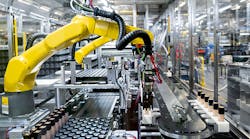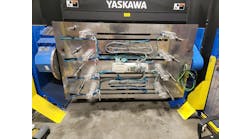A Control Design reader writes: Our contract packaging operation is implementing more robots. First, we were using delta pickers. Then we added a couple articulated arms mounted on an inverted gantry for machine tending. We’re interested in making these part of collaborative applications and maybe even looking into these new autonomous mobile robots (AMRs) I keep hearing about. What type of presence sensing or safety components are necessary when we start putting workers and robots in the same areas?
Also read: Warehouses continue to improve efficiency with collaborative robots, AMRs and AGV technology
Answers
Safety certification
Most mobile robot systems outside of goods-to-person (GTP) systems, such as those used by Amazon, are designed to safely operate in mixed human-robot environments out of the gate. However, the level of safety certification varies based on the risk level involved; for instance, a small e-commerce robot designed for moving one to two individual orders at around the walking speed of a human is much less dangerous than an autonomous forklift moving 3,000 lb at 6 mph. Different mobile robot safety standards already exist that manufacturers should be certified for, usually through a third party, based on the level of risk they pose. These standards include ANSI B56.5 and RIA 15.08, which are widely accepted and adopted across the industry by both vendors and end users. The best thing to do if you are unsure is to conduct a risk assessment of your operation and use case, with the assistance of a third party, if necessary, to determine if any additional safety measures are needed beyond what the manufacturer is certified for.
Matthew Cherewka / director of business development and strategy / Vecna Robotics / www.vecnarobotics.com
Speed and separation monitoring vs. force limiting
When it comes to robots and people working collaboratively or in the same area there is no one magic bullet that can be used to make an application safe. Every facility, application and risk level are unique—and it's the responsibility of the end user to complete a risk assessment and verify that an application complies with all safety requirements.
In recent years, a number of advances in robot safety make compliance with these standards much easier to achieve, but to determine the true safety or risk in an application you must consider the entire process.
One very simple example comes from that of a facility that installed collaborative robots, with all the proper guarding, but when it was live on-site it ended up creating an unexpected blind spot where someone might come in contact with a conveyor. The facility needed to install additional guarding to allow the work cell to be operated safely.
There are two ways to work with a robotics system in a collaborative way. The first is speed and separation monitoring. This requires that as a person gets closer to the robot operation, the robot slows to speeds that are safe. As the associate gets closer, the robot gets slower, until eventually, the robot needs to come to a complete stop because the human is close enough that contact between the person and robot cannot be considered safe. There are a number of technologies that can be used to monitor this separation; light curtains, pressure sensing floor mats, and area scanners are a few examples.
The second, and what most people think of when they hear collaborative, is force limiting. In this scenario, the robotic system has internal technology, such that if it comes in contact with a person, the force of that impact is below the threshold considered unsafe. Most of the collaborative robot manufacturers achieve this by limiting the payload and speed of the robot to reduce the overall impact. These robots have become very popular in the past few years, but the downside is that they can’t move as fast as traditional robotics and are limited in the size of boxes they can lift.
Companies are developing sensing technologies that would allow traditional robots with higher speeds and payloads to work collaboratively at full speed.
Autonomous mobile robots (AMRs) have become very popular and effective in reducing the amount of distance an associate is required to travel in a given shift. New AMR manufacturers have simplified the process for mapping the work environment, adjusting to changes in the environment and, most importantly, operating safely. As you consider AMRs for your facility, most manufacturers have robust safety sensing onboard the AMRs, which allow them to operate safely. Through a combination of reduced speed and sensing technologies, such as laser scanners, 3D scanners, and safety-rated circuity, many AMRs are collaborative by design.
Technology such as collaborative robots and AMRs are very quickly allowing human associates and robotic systems to work together safely. While these technologies have safety features inherently built-in, every application is unique. Only in their final form, on the facility floor, can all aspects of an application be reviewed and determined to be collaborative.
Zach Gomez / senior director of global logistics business / Realtime Robotics / https://rtr.ai
Cobot solutions
A robotics solution is determined to be collaborative if it can safely interact with humans or operate in close proximity to humans in a shared workspace. International standards including ISO 10218-1 and ISO/TS 15066 further define collaborative robot applications. Unless a particular robot model was designed by its manufacturer with the intention for collaborative control and operation, it may not be possible to adhere to these definitions and standards. Collaborative design features include speed and force-limiting operation modes when humans are in proximity of the robot and mechanical design factors that minimize the risk of injury when the robot comes into contact with a human. Without these features, it is necessary to restrict any potential human access to the robots and to halt their movements if a human is detected to be in the workspace.
The first step toward making your packaging operation collaborative would then be to replace your robots with equivalent collaborative-robot (cobot) models. Most cobots come in the form of articulated arms. Additionally, cobots often sacrifice speed and payload in exchange for being collaborative. You will need to weigh the benefits of making your solution collaborative against the costs of redesigning your solution to accommodate cobots and the potential reduction in cycle time. Even if you move toward introducing cobots into your application, the entire application must be considered before selecting accompanying safety solutions and considering your application to be collaborative as defined by current standards.
Most cobots have the ability to enter a safe operation mode when connected safety sensors detect people within the workspace. In this operation mode, the cobot may run under limited speed and force settings or stop altogether. The type of safety sensors used to trigger this mode, along with their arrangement, is dependent on the type of application the cobot is performing, as well as its placement within a workspace. If a cobot can potentially trap a person between itself and an object or wall, fixed barriers and gates with guard lock switches may be required to restrict access to these pinch points while the cobot is in operation. In this scenario, the remaining areas without pinch points can be monitored by safety scanners or light curtains. Alternatively, cobot solutions in open areas without these pinch points may employ multiple safety scanners or safety light curtains can provide 360° of proximity detection without the need for fixed barriers.
However, the correct selection and arrangement of safety sensors is dependent on the cobot’s end-of-arm tooling, the potential human body areas the cobot can collide into and the materials the cobot is handling. For example, a cobot equipped with a bladed tool would most likely not be qualified as collaborative and should never operate in proximity of humans. These factors must be considered if a cobot can safely share workspaces with workers at all and be designated to be collaborative.
Regarding AMRs, it’s common for typical AMRs to have a full suite of pre-installed laser and sonar sensors. They could be considered collaborative out-of-the-box, as they can safely navigate around people and obstacles. Despite this, a risk assessment must be performed before deploying AMRs in any given operation. Adequate clearance must be maintained on the sides of the AMR to avoid trapping a person between a wall or fixed objects. Accessories and payloads added to an AMR may expand its size or create overhang, requiring additional side-mounted safety lasers to be mounted to the AMR to provide an increased range of detection. Similar to the case with cobots, safety sensors for an AMR application must be selected based on the type of application, accessories equipped on the AMR, the work environment and materials being handled by the AMR.
Due to the sheer variety of robotics applications and work environments, there’s no cut-and-dried answer as to which safety solutions are appropriate for any given automation solution. The best way to identify the necessary safety equipment needed to comply with collaborative robot standards and keep your workers safe is to reach out to your robot provider for a risk assessment.
Adrian Choy / product manager—robotics / Omron / automation.omron.com
Networking and maintenance considerations
Safety is a multi-faceted and systemic concern. There is no one-size-fits-all answer. The end user, OEM and system integrator need to evaluate working conditions and scenarios carefully together to determine what risks there are to human safety.
Walk through the usage scenarios and put into place measures that account for all known interactions. The specific sensors used to mitigate these safety concerns are directly related to the specific scenario (Figure 1). For example, two-hand controls and safety mats can be used to detect if a maintenance technician or operator is in a zone or at a control station. Lockout gates, light curtains and safety zone sensors can also play a role based on the specific risk assessment and needs. Additionally, there have been many advances in safety-rated motion control, which can add another layer of protection and allow for human, collaborative interaction with robots and machines.
Remember that the cycle time of the network you choose to tie these disparate systems together will also play a large role in any physical offsets needed due to reaction times. Implementing integrated safety on a fieldbus like EtherCAT may allow for a much smaller footprint. You might also want to consider a zoned safety approach to maintain as much productivity as possible, while still meeting safety needs.
And don’t forget maintenance. The Occupational Safety and Health Administration (OSHA) website (www.osha.gov/robotics) states: “Studies indicate that many robot accidents occur during non-routine operating conditions, such as programming, maintenance, testing, setup or adjustment. During many of these operations the worker may temporarily be within the robot's working envelope where unintended operations could result in injuries.”
What maintenance, programming and other operations outside normal usage are to be expected? Remember to account for these as well to have the safest machine possible.
Rick Forsgren / packaging industry specialist / Beckhoff Automation / www.beckhoff.com
Predetermine safety zones
Collaborative robots by definition don’t need additional safety equipment. Precautions like short barriers could be added to keep nonessential personnel from entering the work cell but are often not required if the work cell is properly laid out. Check with your robot supplier to obtain their safe speed rating.
Presence sensing is most often used when an operator only needs to spend a brief period of time in close contact with a process involving a robot, often not collaborative, or other machine/assembly center. Presence sensing allows for several machine safety modes to exist in the same space. One of the more common applications of this technology allows for a standard industrial robot to run at full or near full speed when the sensor does not detect a presence in a predetermined safety zone. Once someone or something is detected, the robot will automatically shift into a slower speed or stop depending on several calculated safety ranges.
Autonomous mobile robots by design do not require any additional safety equipment. By the very nature of their function, they carry an onboard suite of safety devices. That said, depending on how they are applied and deployed, additional safety equipment like fencing may be required for areas like pickup and drop-off points or any other instance where you would want to protect personnel from the robot’s interaction with one of its programmed processes.
Earl Wohlrab / director, product strategy & innovation / BW Integrated Systems / www.bwintegratedsystems.com
Mobile robot standards
This is a very timely question as standards are being examined to make sure that they are current and relevant. You definitely should be citing ANSI R15.08-1-2020. This standard has been written over the past six years to develop a common set of requirements for mobile robots. References to the safety of human workers in the same space is definitely addressed. For further details, I would suggest consulting ANSI B155.1-2016, which is the Safety Requirements for Packaging and Process Machinery developed by the Association for Packaging and Processing Technologies, a standards development organization. I think you will find clear explanations to the presence-sensing safety components that you will need in these publications. Good luck with your expansion.
Perry Hudson / key account manager—packaging / Pepperl+Fuchs / www.pepperl-fuchs.com





